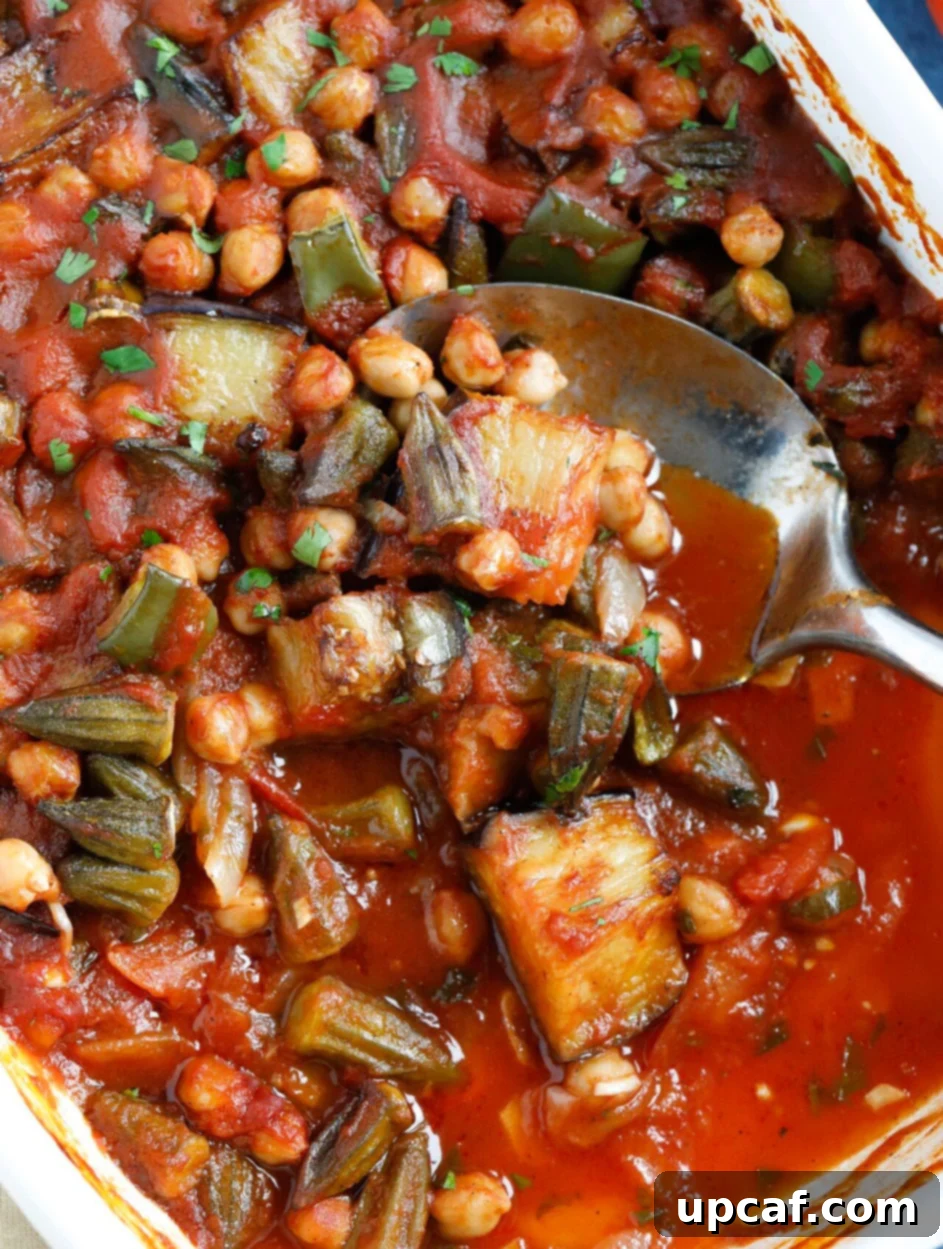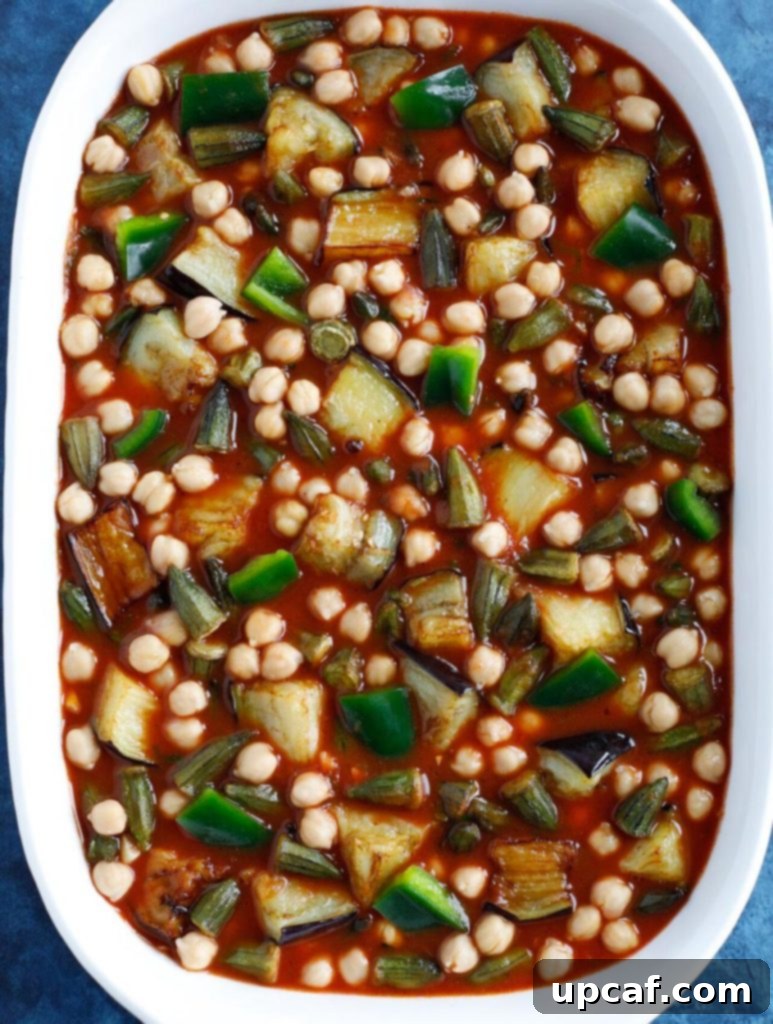Discover the delightful world of Maghmour (Lebanese Moussaka), a truly exceptional dish from the heart of Middle Eastern cuisine. This vibrant and flavorful recipe offers a unique culinary experience, whether enjoyed warm or chilled. It’s renowned across the Levant for its versatility and wholesome goodness, easily adaptable to a vegetarian preference or enriched with meat. With a total preparation and cooking time of just 45 minutes, it stands out as an ideal solution for a quick yet satisfying weeknight dinner, and its flavors deepen beautifully when made ahead, making it perfect for meal prep or entertaining.

This authentic Lebanese recipe holds a cherished place in my memory, evoking nostalgic flavors from my childhood. It’s more than just a dish; it’s a taste of home and a connection to my roots. Alongside other traditional favorites like Sheikh El Mahshi, Maghmour ranks high among my most beloved main dishes. Its rich, savory profile also makes it an excellent choice as a flavorful appetizer. My dear grandmother frequently prepared this comforting meal for me, and now, I find immense joy in sharing this culinary legacy with my own children, recreating the warmth and love embedded in every spoonful.
What is Maghmour (Lebanese Moussaka)?
While the name “Moussaka” might bring to mind its more famous Greek counterpart, Lebanese Maghmour offers a distinctly different and equally delicious experience. Unlike the layered meat and potato casserole often associated with Greek Moussaka, Maghmour is a vibrant vegetable-centric stew, brimming with wholesome ingredients like eggplant, chickpeas, and ripe tomatoes. It typically embraces a plant-based foundation, though some variations do include beef or other meats, especially for those who prefer a heartier meal.
This dish captures the essence of Mediterranean cooking with its fresh produce and aromatic spices. Its unique character lies in the harmonious blend of textures and flavors, from the tender, melt-in-your-mouth eggplant to the hearty chickpeas, all simmered in a rich tomato sauce infused with traditional Lebanese spices. It’s a testament to the region’s ability to transform simple, natural ingredients into an extraordinary feast for the senses.
I vividly recall my grandmother’s Maghmour; it was always the first dish she’d prepare for me upon my visits to Lebanon. She often made hers with a touch of meat, adding a depth of flavor that only a grandmother’s cooking can achieve. Those culinary memories are priceless, and just thinking of her delicious Maghmour still makes my mouth water. Her ability to infuse such profound flavor and love into every dish is something I deeply miss and strive to emulate in my own kitchen.
How to Make Authentic Maghmour (Lebanese Moussaka)
Creating this traditional Lebanese moussaka is a straightforward process, beginning with the careful preparation of its core vegetables. The stars of Maghmour are undoubtedly eggplant and, in my preferred version, baby okra. While okra isn’t universally included in every Maghmour recipe, its presence adds a unique texture and subtle sweetness that truly elevates the dish to an extra delicious level. Don’t hesitate to include it!
Preparing the Star Vegetables: Eggplant and Okra
For the eggplant, begin by cubing it into bite-sized pieces. To achieve that signature rich flavor and tender texture, frying the eggplant is highly recommended. While grilling is a lighter alternative, frying truly transforms the eggplant, imparting a depth of flavor that is simply unparalleled. After frying, gently lay the eggplant cubes on paper towels to thoroughly drain any excess oil, ensuring your Maghmour isn’t greasy. This step is crucial for the perfect texture.
When it comes to okra, convenience meets flavor with frozen baby okra, which is readily available in most grocery stores and works just as wonderfully as fresh. Fresh okra might not always be in season, so don’t let that deter you from making this dish. Simply fry the frozen okra until tender and slightly browned, then place it on paper towels alongside the eggplant to drain. For an added layer of flavor and a touch of color, I also incorporate some cubed green bell peppers. If you enjoy a bit of heat, a finely diced jalapeño can be a fantastic addition, offering a subtle kick without overpowering the dish.
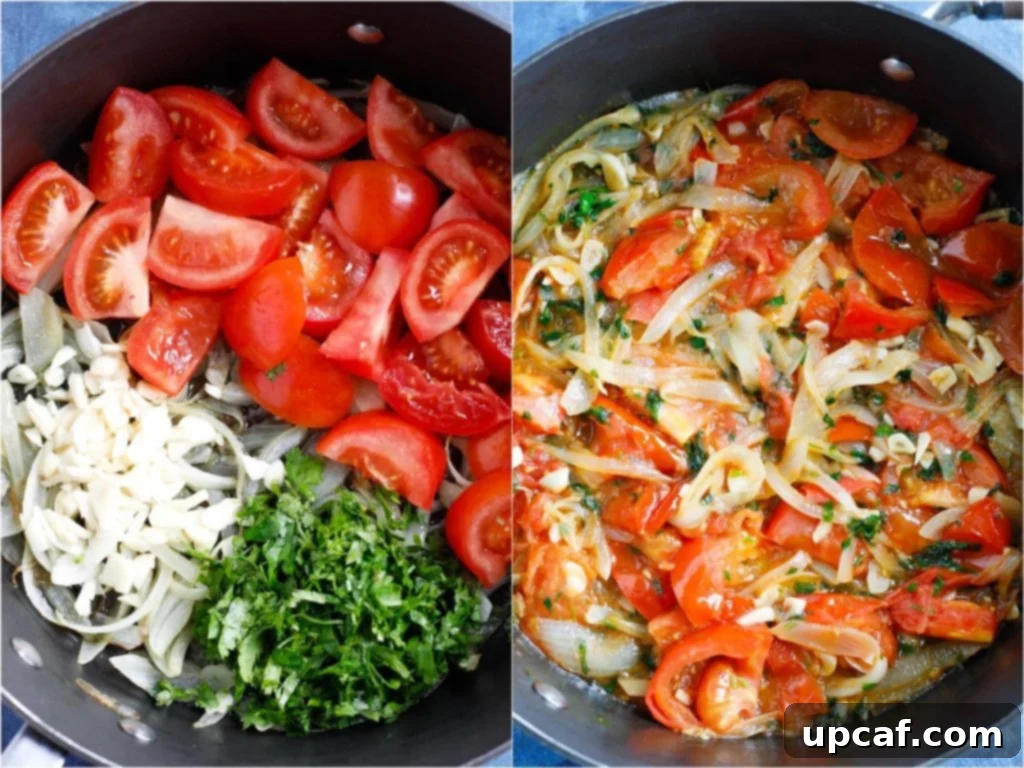
Crafting the Aromatic Tomato Sauce
The heart of Maghmour lies in its rich and aromatic tomato sauce. Begin by sautéing sliced onions in good quality olive oil until they achieve a beautiful, caramelized golden hue. This slow caramelization brings out their natural sweetness, forming a delicious base for the sauce. Next, introduce minced garlic, fresh cilantro, and the cubed fresh tomatoes, stirring them gently into the caramelized onions. Sauté this vibrant mixture for a few minutes, allowing the flavors to meld.
Once combined, reduce the heat, cover the skillet, and let the tomatoes simmer for several minutes. This gentle cooking process ensures the fresh tomatoes break down, becoming incredibly tender and juicy. Uncover the skillet and, using a wooden spoon, mash the softened tomatoes to create a rustic, saucy texture. Now, enhance the depth of flavor by stirring in canned tomato puree sauce, a generous helping of tomato paste for intensity, and a carefully balanced blend of traditional spices, along with salt and water. Give everything a good stir, cover once more, and allow the sauce to simmer for an additional few minutes, allowing the spices to fully bloom and integrate into the rich tomato base.
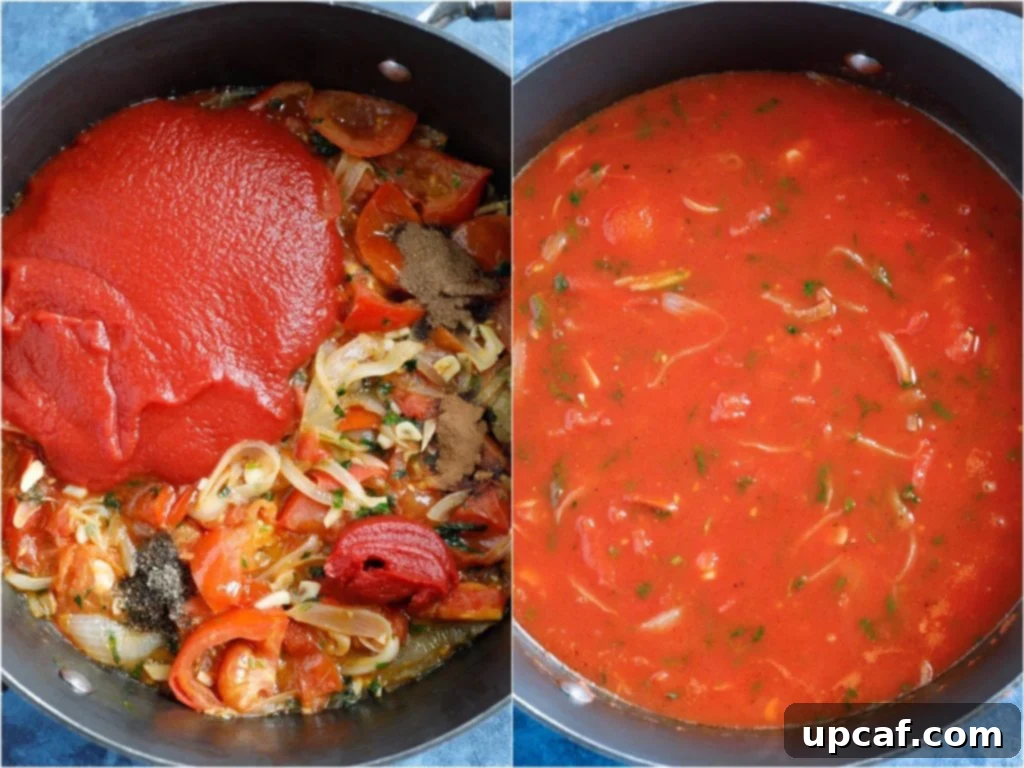
Assembling and Baking Your Maghmour
With your components ready, it’s time for assembly. Pour a foundational layer of the fragrant tomato sauce into a baking dish. This ensures every bite is infused with its rich flavor. Then, artfully arrange the remainder of your prepared ingredients—the fried eggplant, okra, chickpeas, and bell peppers—evenly over the sauce. The visual appeal of the vibrant vegetables peeking through the sauce adds to the anticipation of this rustic dish.
Once assembled, cover the baking dish securely with aluminum foil. This crucial step helps steam the vegetables, ensuring they cook through evenly and remain tender, preventing the tops from browning or burning prematurely. Bake the Maghmour in a preheated oven, allowing the flavors to deepen and meld into a cohesive, comforting masterpiece. The aromas filling your kitchen will be absolutely irresistible.
Recipe Notes and Expert Tips for Perfect Maghmour
- Adding Meat or Chicken: While traditionally a vegetarian dish, Maghmour welcomes additions. If you wish to incorporate meat or chicken, season your chosen protein (such as ground beef, lamb, or cubed chicken breast) with salt and pepper. Sear it thoroughly on both sides in a separate pan before layering it into the baking dish with the vegetables and sauce. This pre-searing step locks in flavor and ensures even cooking.
- Preheat Your Oven for Even Cooking: Always remember to preheat your oven. Turning it on as you begin sautéing your vegetables allows it to reach the desired temperature by the time your Maghmour is ready for baking. Cooking in a preheated oven ensures the dish bakes uniformly, resulting in perfectly cooked vegetables and a well-integrated sauce.
- Cover with Foil for Optimal Tenderness: Covering the baking dish with aluminum foil during the initial baking phase is key to preventing the top layer of vegetables from drying out or burning. The foil traps steam, ensuring that the eggplant and okra remain incredibly tender and infused with the rich tomato flavors, contributing to the dish’s moist and succulent texture.
- Personalize Your Maghmour: This recipe is wonderfully adaptable! Feel empowered to make it your own by adding other vegetables you might have on hand. Mushrooms, zucchini, or even potatoes can be fantastic additions, lending different textures and flavors. It’s a great way to minimize food waste and explore new taste combinations within the traditional framework of Maghmour.
Frequently Asked Questions About Maghmour
How Do You Serve Maghmour?
The word “Moussaka” in this context often implies a dish that can be served chilled, and indeed, Maghmour is delightful both hot and cold. While many prefer it as a cold dish, particularly during warmer months, enjoying it warm straight from the oven is equally comforting. Traditionally, Maghmour is often considered an appetizer or a side dish in Lebanese cuisine. However, its hearty blend of vegetables, chickpeas, and rich sauce makes it substantial enough to be served as a satisfying main course. For a protein boost, consider adding chicken or meat, as detailed in our recipe notes.
To truly embrace the Lebanese experience, serve your Maghmour with warm, fresh pita bread, perfect for scooping up the flavorful sauce and tender vegetables. If you’re presenting it as a main meal, complement it with a side of fluffy couscous or traditional Lebanese Vermicelli rice. For those who prefer it chilled, simply allow the cooked Maghmour to cool to room temperature, then cover and refrigerate for an hour or two before serving. The flavors will have intensified, creating an even more harmonious and refreshing dish.
Can Maghmour Be Made Ahead of Time?
Absolutely! Maghmour is an exceptional choice for meal prepping and tastes even better the next day as the flavors have ample time to meld and deepen. Once cooked, allow the Maghmour to cool completely to room temperature before transferring it to an airtight container. Stored in the refrigerator, it will maintain its deliciousness for up to 3 days, making it a convenient option for lunches or quick dinners throughout the week.
For longer storage, Lebanese Moussaka freezes beautifully. You can freeze it in an airtight, freezer-safe container for up to 3 months. To enjoy, simply thaw it overnight in the refrigerator before reheating gently on the stovetop or in the oven, or serve it chilled directly after thawing for a refreshing meal. This make-ahead capability ensures you always have a wholesome and delicious option ready to go.
Is Maghmour Vegan?
Yes, this traditional Maghmour recipe is inherently vegan, making it a wonderful option for plant-based diets and a healthy choice for any family. Thanks to the generous inclusion of chickpeas, it provides a substantial amount of plant-based protein and complex carbohydrates, making it a well-balanced and incredibly filling meal on its own. Packed with a vibrant array of fresh vegetables, Maghmour is a dish you can feel great about serving, knowing it’s nourishing, delicious, and aligns with a healthy lifestyle. Its rich flavors and satisfying textures prove that plant-based meals can be both wholesome and incredibly gourmet.
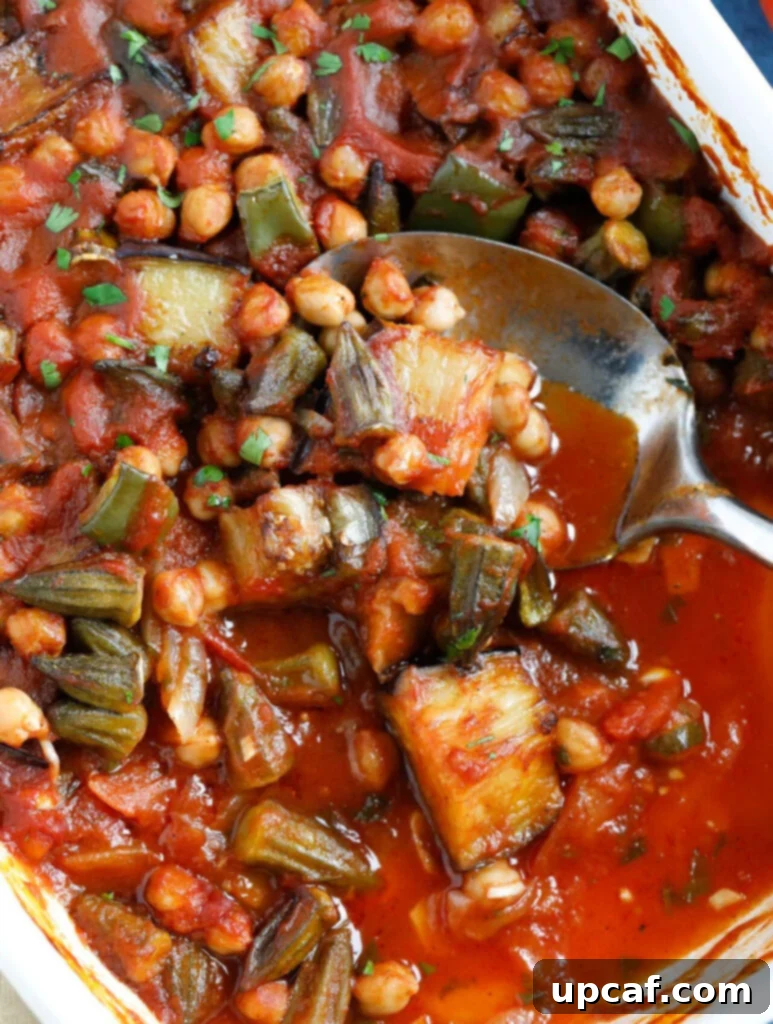
I truly cannot emphasize enough how much I adore this Maghmour recipe! It stands as one of my all-time favorites, and I am absolutely confident that you will fall in love with it too. Its vibrant blend of flavors, coupled with its straightforward preparation, makes it a truly irresistible dish that brings joy and tradition to any table.
More Delicious Lebanese Recipes
- Lebanese Cheese Rolls
- Lebanese Rice Pudding
- Maamoul Date Cookies
- Lebanese Spicy Potatoes (Batata Harra)
- Easy Beef Shawarma Bowl
I sincerely hope you savor every recipe I share, including this incredibly flavorful and simple Maghmour. I encourage you to try preparing it, enjoy its delightful taste, and share this wonderful experience with your cherished friends and family!
To stay updated with all the new recipes I post, be sure to sign up for my blog newsletter to receive them straight to your inbox. And don’t forget to tag me on INSTAGRAM so I can admire your delicious culinary creations. Until our next recipe, XoXo…
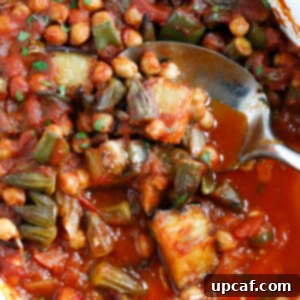
Maghmour (Lebanese Moussaka)
By: Mariam Ezzeddine
This Maghmour (Lebanese Moussaka) is a super delicious recipe you can enjoy hot or cold. It’s very famous in the Middle East and can be made with or without meat for a vegetarian option.
Prep Time: 15 minutes
Cook Time: 30 minutes
Total Time: 45 minutes
Servings: 8 servings
Ingredients
- 1 lb fresh plum tomatoes, cubed
- 5 cloves garlic, chopped
- 1 medium onion, sliced
- 1/2 cup chopped cilantro, fresh only
- 1 tbsp. black pepper
- 1 tsp. 7 spice
- 1/2 tsp. cinnamon powder
- 1.5 tsp salt
- 1 can chickpeas, drained and rinsed
- 2 cups baby okra, fried
- 2 medium sized eggplant or 1 large, cubed and fried
- 12 oz. tomato puree sauce
- 2 tbsps. tomato paste
- 1/2 green bell pepper, cubed
- 4 cups water
- 2 tbsps. olive oil
Instructions
- In a large skillet or pot, heat the olive oil over medium heat. Add the sliced onions and sauté until they are soft and caramelized to a golden brown.
- Stir in the cubed fresh tomatoes, chopped cilantro, and minced garlic. Sauté for a few minutes, stirring frequently, until fragrant.
- Reduce the heat to medium-low, cover the skillet, and simmer for about 5 minutes, allowing the tomatoes to soften. Uncover and gently mash the tomatoes with a wooden spoon to create a chunky sauce.
- Add the tomato paste, tomato puree sauce, black pepper, 7 spice, cinnamon powder, salt, and water. Mix everything well until thoroughly combined.
- Increase the heat slightly, bring to a gentle simmer, then cover and cook for another 5 minutes, allowing the flavors to meld.
- Remove the tomato sauce from the heat. Pour about half of the sauce into a 9×13 inch baking dish (or similar size).
- Evenly spread the fried eggplant, fried baby okra, drained chickpeas, and cubed green bell pepper over the sauce in the baking dish. Pour the remaining tomato sauce over the vegetables, ensuring everything is well coated.
- Cover the baking dish tightly with aluminum foil. Bake in a preheated 375°F (190°C) oven for 30 minutes.
- Carefully remove the Maghmour from the oven. Serve hot for a comforting meal, or allow it to cool to room temperature before refrigerating for a chilled appetizer or side dish.
- Store any leftovers in an airtight container in the refrigerator for up to 3 days.
Notes
- You can add meat or chicken to this dish. Season it with salt and pepper and sear on both sides before baking it in the dish.
- Preheat the oven. Turn the oven on while you are sautéing the veggies. Cooking it in a preheated oven will help it cook through evenly.
- Cover the baking dish with foil when you cook it. This will stop the tops of the veggies from browning and getting burnt, keeping them tender.
- Make it your own! Feel free to add in additional vegetables in this dish that you need to use up. Mushrooms work really well!
Nutrition
Serving: 1g | Calories: 138kcal | Carbohydrates: 20.8g | Protein: 5.5g | Fat: 9.2g | Saturated Fat: 4.3g | Sodium: 613.2mg | Sugar: 7.2g
Like this recipe? Rate and comment below!
